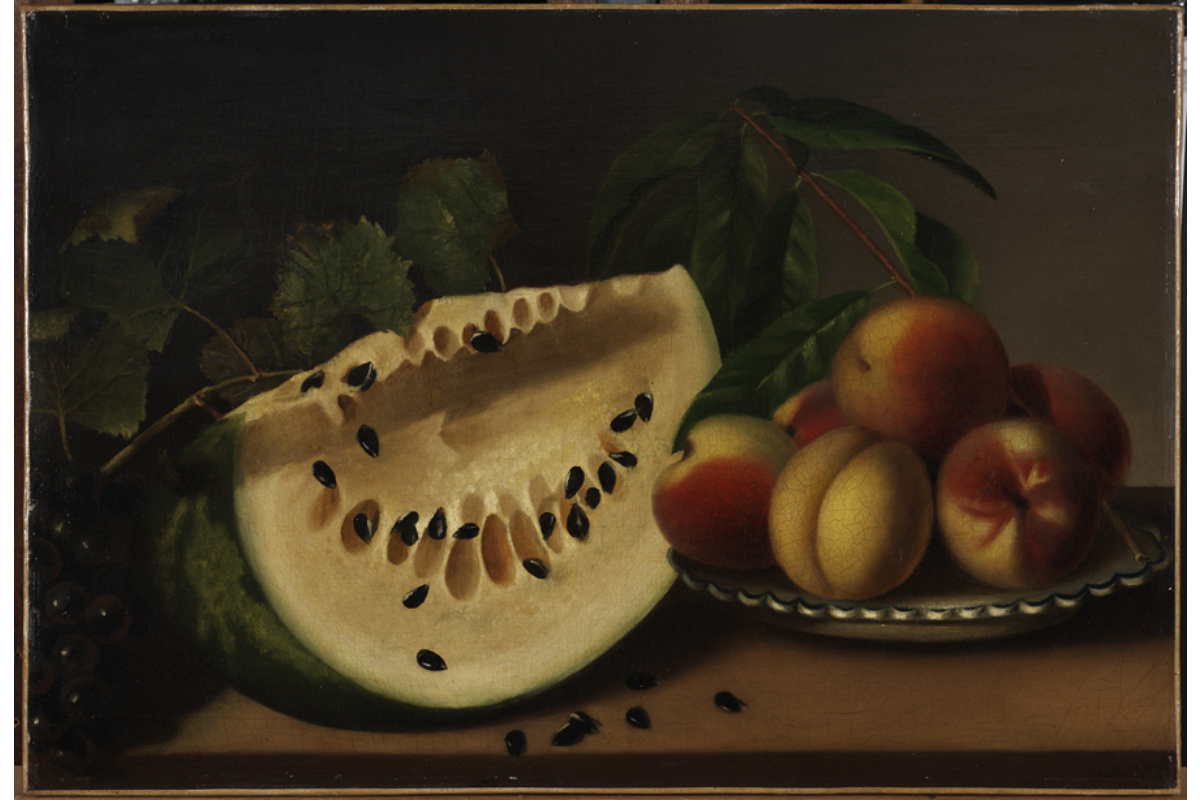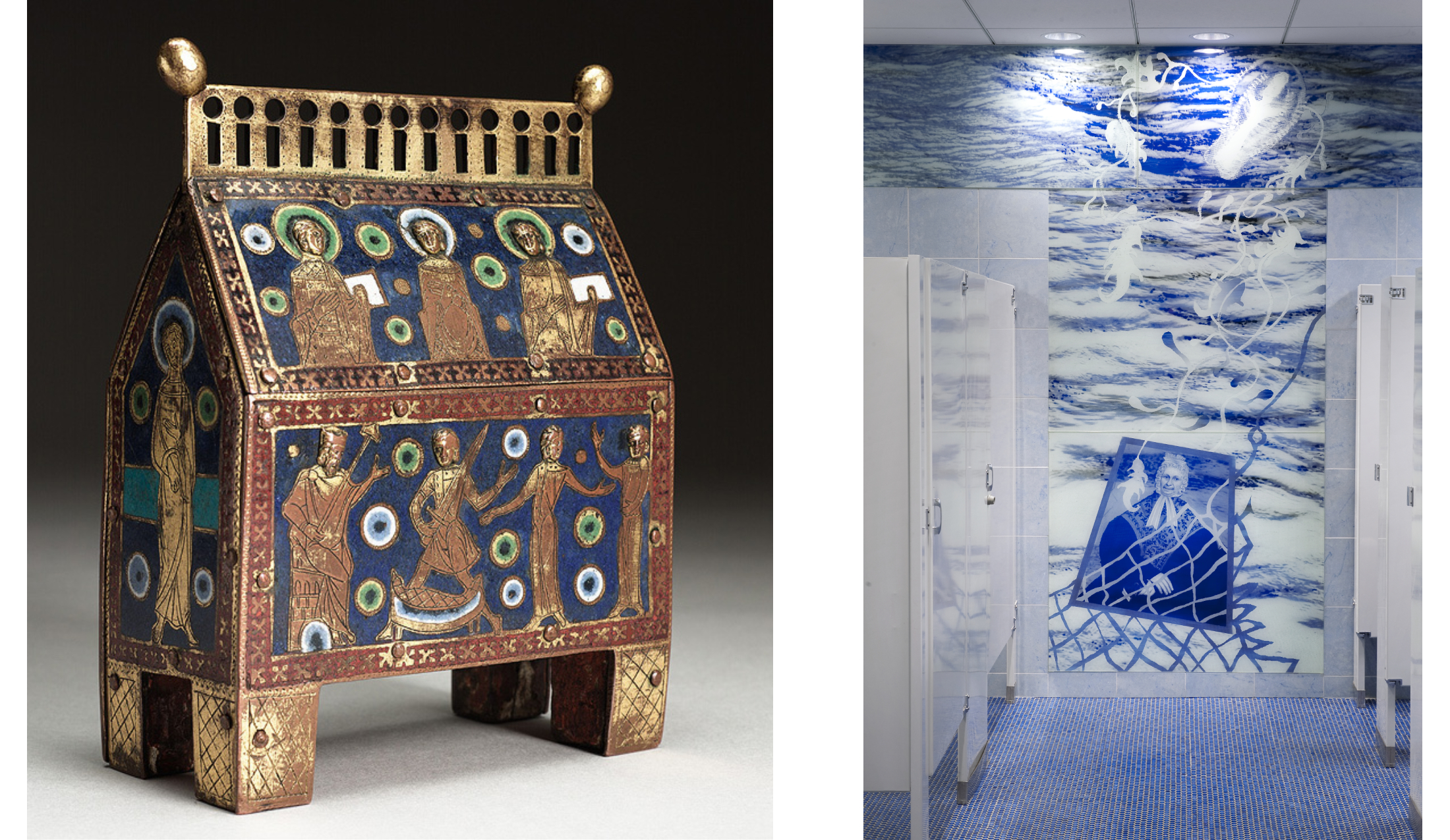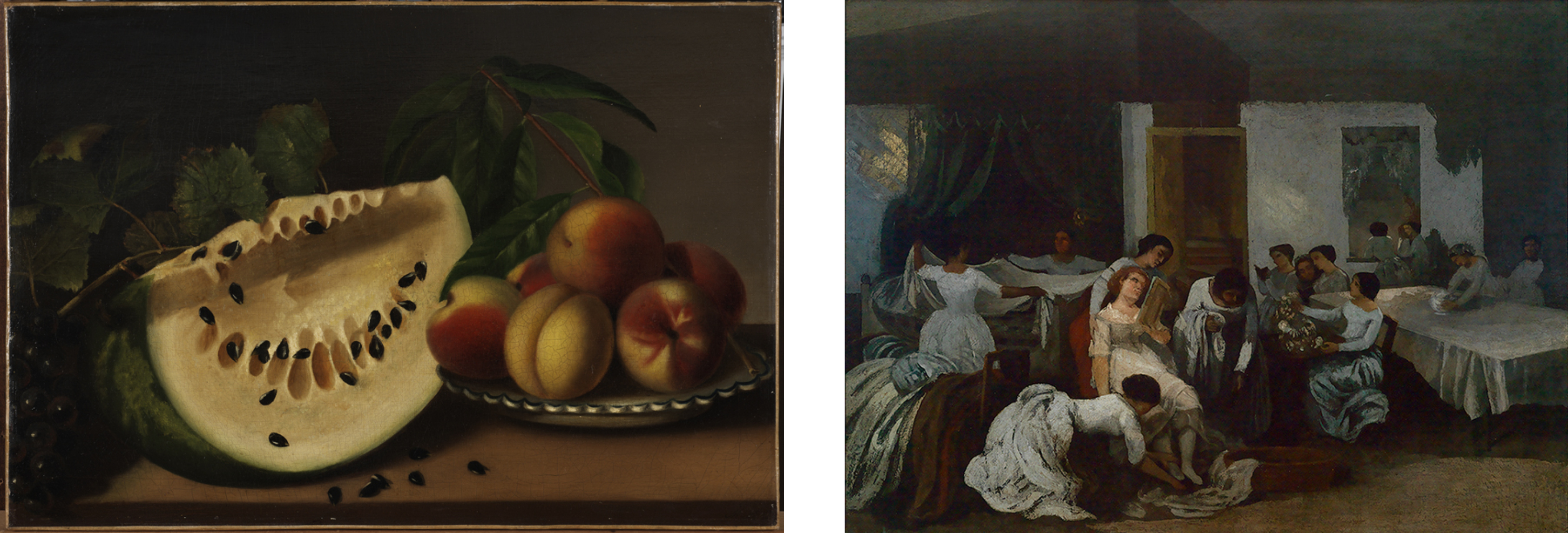
From Home: An Interview with Matt Donovan
Sophie Poux is a student assistant at the Cunningham Center, a Government major, and a member of the class of 2021. From Home is a series of interviews she is conducting remotely this fall.
Matt Donovan is the author of two collections of poetry – Vellum (Mariner, 2007) and Rapture & the Big Bam (Tupelo Press, 2017) – as well as the nonfiction collection of lyric essays A Cloud of Unusual Size and Shape: Meditations on Ruin and Redemption (Trinity University Press, 2016). His work has appeared in numerous literary journals and “House of the Vettii” was selected as a notable essay for The Best American Essays 2013. He is the recipient of numerous accolades including a Whiting Award, a Rome Prize in Literature, a Pushcart Prize, an NEA Fellowship in Literature, and the Larry Levis Reading Prize. In 2016, he received a Creative Capital Grant for the chamber opera Inheritance, which premiered in 2018 at UC San Diego. Matt is the director of the Boutelle-Day Poetry Center and a professor of Practice in English Language & Literature at Smith College.
Last week, I sat down with Matt to ask him about The Map of Every Lilac Leaf: Poets Respond to the Smith College Museum of Art, a collaboration between the Boutelle-Day Poetry Center and the Smith College Museum of Art which was released earlier this week as a part of SCMA100, the Museum’s centennial celebration. We talked about how this project came together, what’s next for the Poetry Center, and whether he’s been writing in quarantine.
Matt, what does your job as the Director of the Boutelle-Day Poetry Center and a professor entail and how has that changed over the past six months?
My primary tasks are offering the reading series, teaching English 112: Reading Contemporary Poetry, running the poetry concentration, and working on outreach.
The reading series is going strong: like every year, we have an incredible lineup of visiting poets. Whereas there is absolutely, admittedly, no substitute for a live, in-person poetry reading, at the same time, we have had an outpouring of interest in the events from people all over. Over 450 people attended the Mark Doty reading last week! While there can be a disconnect using Zoom as the platform for these readings, it can also feel more intimate. Mark Doty wasn't this formidable, legendary poet behind a podium: he was reading poems to us in his living room. At one point his golden retriever, Ned, walked by and started chewing on milk cartons from the recycling. It just felt very personal!
This semester, there are 60 students taking English 112. It can be challenging to coordinate that discussion about poetry when you have 60 people in a Zoom class but the students are rising to the occasion. As always, they have such incredible insights into the work and are teaching me about the poems. There seems to be a catharsis happening: the work is resonating because we're all thirsty for meaning. I think we're desperately needing an antidote to the toxic dialogue in the world right now, especially during this presidential season – at least that's the way I’m interpreting it. To encounter language that is rarefied and thoughtful feels really refreshing and meaningful in trying to speak to experience.
As for the poetry concentration, we have about 15 students who are concentrators. We’re encouraging the students to pursue things for the concentration that are directly customized to their own interest and course of study. Whereas a lot of students still write incredible chapbooks of poems, other students are interested in pursuing variations of that. I worked with a student on an independent study last spring that was a bilingual text. They were writing poems in both Spanish and English and rather than a translation, they were offering versions of both. Students could also work in poetry and education or poetry and community arts, for instance.
In terms of outreach, I’m thinking about ways to bring poetry to elementary, middle and high school students. Two years ago, my first year at Smith, the Poetry Center did a collaboration with the Campus School which was just delightful. An exemplary poetry student was in the classroom developing curriculum with the teachers and then delivering the content to third grade students. At the end, the third graders wrote and illustrated poems about place and rivers. We produced a book and they did a reading at the Poetry Center and it was, oh it was so lovely! We will get back to that kind of work with the Campus School and elementary school students for sure.
Meanwhile, though, I began thinking last spring about trying to find ways to continue our outreach. I've heard so many poets come to the Poetry Center and say they were only reading poets like Robert Frost and William Shakespeare when they were in high school. For a new project, The Poem I Wish I Had Read, I'm asking poets to discuss and then read in short, five-minute videos, a poem they wish that they had encountered when they were a high school student. For Danez Smith, for example, to say that it never occurred to them that anyone but a dead white male would ever write a poem was so horrifying, but I understood it. I think a lot of high school curriculum isn't as thoughtful as it should be about making sure that there are poems by a diversity of poets which resonate with students. It's all fine and good to read a William Shakespeare love sonnet but there's work that might speak to high school students’ emotions or their identity or their experiences as teenagers in a much more direct way while also providing a gateway to appreciation of Shakespeare and Frost. It’s been really exhilarating to work on this project. The videos are irreverent and funny and candid. We're going to have a YouTube channel that will launch in the spring and I hope it becomes something that we can work on in an ongoing way.
Would you speak a little more about the process of putting together The Map of Every Lilac Leaf? Where did this idea even come from?
I made this pitch to the museum pretty early on in my time at Smith, I think within the first month. The idea stemmed from two things: one, my own interest in the ekphrastic tradition, and two, it's just such an incredible collection! I immediately thought that the SCMA collection would be pure gravy to poets. If it weren’t, the project couldn't have taken place in the same way. Jessica Nicoll, Museums Concentration Director and Director and Louise Ines Doyle ’34 Chief Curator at the Museum, is such a wonderful collaborator. She was immediately game for the project and also wanted the collaboration to be part of the centennial celebration. I didn’t know that we were approaching the centennial of the Museum's collection, so that part was really serendipitous.
How did each poet choose a work from the SCMA collection?
Some poets, including a number of the six alumni poets who contributed to the book and read for the launch last week, had a work in mind. Laurie Ann Guerrero AC ’08 knew that she wanted to write about the reliquary box and Meg Day mentioned the Museum bathrooms as a possibility from the outset. Their poem is a profound meditation on gender and identity and binary thinking that has transformed my experience of that work of art.

Left: Unknown. French, 13th century. Reliquary with the Judgement of Solomon or the Martyrdom of Saint Valerie, ca. 1200–1210. Champlevé enamel on copper. Purchased with the gift of Louise Ines Doyle, class of 1934. SC 2006.50.
Right: Driscoll, Ellen. American, born 1954. Catching the Drift; Restroom Project, 2001. Porcelain bathroom fixtures and wall tiles. Made possible by funding from the Kohler Trust for Arts and Education and Kohler Company. The altered plumbing products were created by Ellen Driscoll in Arts/Industry, a longterm artist-in-residence program of the John Michael Kohler Arts Center of Sheboygan, Wisconsin. SC TR 6286.1.
I also worked with a Poetry Center intern, Julia Faulkner, who's a wonderful poet in her own right. Julia thought about work to pitch to the different poets relying upon a complex knowledge of that poet’s themes and interests and an understanding of the collection. She curated about 12 to 15 different works that we sent to some of the poets.
I have to say that it was one of the most incredible privileges and pleasures of my job, of any job I've ever had, to walk with poets over to the Museum and have intimate encounters with the work. Part of it was experiencing work that the Museum doesn't always have the opportunity to show, and part of it was the intimate engagement. I got filled with such joy and excitement, being down in those back rooms and seeing things pulled from crates and or laid out on a table. It’s so different from the experience of seeing work on a wall with the curatorial spacing. It was especially exciting to be there while the work was triggering possibilities for the poets.
Tell me about the poem that you wrote for The Map of Every Lilac Leaf.
There's a funny story here. The Peale is a painting that I was drawn to but I wasn't sure what the angle would be, and I had a number of other works on my list as possibilities, including the Courbet [that Dana Levin eventually chose to reflect on] because it has such a rich, tantalizing history. Then, Jessica had an idea for making a public presentation about this project as part of the centennial launch in November 2019, and she asked me if I could finish the poem before that date in order to read it at the celebration. And then she turned to me and said “no dirges!” She qualified that by saying “make sure that the poem is fitting to the occasion.” I think she wanted me to write a poem that would be a celebration in tone and mark the occasion, which I was game for. Jessica cracked me up – I think she was worried but what poets can get up to with their melancholy so wanted to preempt that. But ultimately, asking how this small, 19th century still life can still be meaningful, can resonate, can be relevant and nourish our experience during this tumultuous time (which has subsequently got even more tumultuous) was the entry point for me.

Left: Peale, Margaretta Angelica. American, 1795–1882. Still Life with Watermelon and Peaches, 1828. Oil on canvas. Purchased with the anonymous gift of a member of the class of 1952. SC 1952.53. Right: Courbet, Gustave. French, 1819−1877. Preparation of the Dead Girl, ca. 1850−55. Oil on canvas. Purchased with the Drayton Hillyer Fund. SC 1929.1.
What has it been like to see this project in its final form?
I was really excited about the work that the poets would produce but what I hadn't been thinking about when I first pitched the project, to be completely honest, is just how beautiful the book would be. I don’t even remember if I was even thinking about having the visual art in the book. Carolyn Eckert is a local designer who the museum recommended and she was immediately excited. Carolyn understood the vision of the idea and from the outset had her own vision of how the book design could connect to the project's intentions. What the collaboration with the Museum produced, what Carolyn made, is an incredible work of art in itself. For me, it’s a really exhilarating final product and it's been really gratifying to hear the responses from the contributing poets. Carl Philips wrote to me and called it an “illumination in the cave of quarantine.”
What’s next for the Boutelle-Day Poetry Center?
Long-term, I am incredibly excited about that outreach project – that is one of the main things that we're focused on right now – and this incredible gift from the Tammis Day Foundation is transformative for us. I want to expand the Poetry Center committee and have a subcommittee that is focused on outreach.
On the 21st of October we have the Tracy K. Smith reading. That's just a huge event for us. We wanted to have someone who was fitting for this occasion to mark our celebration of the renaming, and also to have tributes in that event to Tammis Day and Annie Boutelle, the founder of the Poetry Center. I have to say, it feels really good to have things to celebrate right now. That will include a from a group of Smith student poetry concentrators who will hold a Q&A with Tracy K. Smith. I'm looking forward to being a fly on the wall.
Are you doing any writing right now? Is there room for writing in your life at this moment?
Right now my writing is paused, but it's been really productive. From last October until August, I've been working really hard on a new poetry project. It's a book that is exploring guns, using them as a way of facilitating a portrait of America. I am really concerned about firearms in this country, and it seems like one of our most pressing issues, but I'm also concerned about the polarization and how real dialogue wasn't happening. Most of the book stems from travel that I did, going to places like Cody, Wyoming, which has the most guns per capita than anywhere in the country, talking to people in Sandy Hook, Las Vegas, Chicago, Cleveland, and just trying to have real conversations. I then used that material to interrogate the issue and try to make sense of it, and also, frankly, paint a portrait of our insanity around the issue too. The stats are very clear: 90% of gun owners support basic restrictions on who can own what kind of weapon and we still can't get it done. Trying to have authentic encounters became one of the guiding principles of the work.
This project goes back about five years and I’ve essentially completed the manuscript. It started out as a nonfiction book that gradually became a book of poetry and I was really surprised at that: poetry seemed to offer ways of approaching material and opportunities to explore this issue through metaphor and images in a way that writing about it in a much more direct, literary journalism manner, surprisingly didn't afford. Poetry ended up feeling more efficacious, more meaningful as a way of grappling with the material.
But I'm also really happy to not write a poem that uses the word gun. Whenever the next stage of inspiration happens, I really hope it has nothing to do with guns at all because it's complicated, exhausting material as well. I'm glad to have it out and we'll see what happens on the publisher side. I know it's also not easy material for other people to encounter. I think the presiding idea is that you either hate guns and don't want to read about them or you love guns and don't need some poet telling you anything about the world of guns.
In the forward to The Map of Every Lilac Leaf, you and Jessica wrote: "this book is a testimony to the purpose of art, which is, after all, not to exist in some cloistered room for its own sake, but rather is meant to be seen, and in being seen, to exhilarate, provoke, challenge, inspire and widen one's world.” I really love this line. Something that's been interesting for me as I've begun to conduct interviews like this one is hearing about the role of art in everyone’s life at this moment. I'm curious: what is the role of art in your life, what is it doing for you right now?
I think it sort of varies, not even just day to day but moment to moment for me. There are times when I only want to encounter poetry that's really speaking to this moment, that is really grappling with the issues of, say, race in our country, and trying to contend with them in a meaningful and complicated way that helps me understand the issue. Then there are other times when I just want to read a haiku by Issa that is offering some sort of rarefied alternative, that is affording some kind of grounding and solace out of the chaos and noise of this moment.
I don't think there is one purpose to art. It can offer consolation, it can offer meaning, it can offer beauty and meaning through that beauty, it can offer a resonant way of understanding; that can be the human condition, that can be the political moment, that can be putting the finger on the pulse but it also can be just a way of interrogating or giving voice to what it means to be on this earth and in this life, and a reminder also that it is grace and human connections that matter in this moment.
I really want to credit Jessica with articulating those ideas. This project wasn't about putting this art up on a pedestal but, rather, welcoming any response that one might have to it. There is such a variety of approaches and tones from these poets, some of which are completely irreverent and some which even call to task the artist. I think this speaks to the SCMA as a teaching museum: privileging welcoming, meaningful encounters with the art.